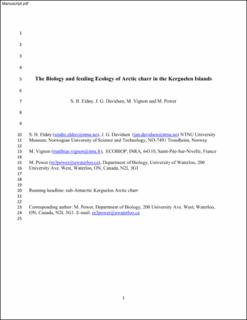| dc.contributor.author | Eldøy, Sindre Håvarstein | |
| dc.contributor.author | Davidsen, Jan Grimsrud | |
| dc.contributor.author | Vignon, Matthias | |
| dc.contributor.author | Power, Michael | |
| dc.date.accessioned | 2021-03-16T10:19:10Z | |
| dc.date.available | 2021-03-16T10:19:10Z | |
| dc.date.created | 2020-10-22T17:50:40Z | |
| dc.date.issued | 2020 | |
| dc.identifier.citation | Journal of Fish Biology. 2020, 98 (2), 526-536. | en_US |
| dc.identifier.issn | 0022-1112 | |
| dc.identifier.uri | https://hdl.handle.net/11250/2733584 | |
| dc.description.abstract | Subsequent to their introduction in the 1950s, Arctic charr Salvelinus alpinus have been able to establish a self‐sustaining population that has adapted to the unique conditions of the sub‐Antarctic Kerguelen Islands. Here, 48 individuals (198–415 mm) were caught with gillnets and their basic biology and feeding ecology were examined using stable isotope analysis. The Lac des Fougères population split use of littoral and pelagic resources evenly, although larger fish relied more heavily on littoral production and appear to follow the size‐dependent life history habitat template seen in many Scandinavian lakes where smaller sized individuals occupy the pelagic zone and larger individuals dominate the littoral habitat. In Kerguelen, Arctic charr mature at the same ages (5.6 years) as Arctic charr in both sub‐Arctic and Arctic lakes. Although mortality was average in comparison to comparator sub‐Arctic lakes, it was high in comparison to Arctic lakes. Maximal age (>7+) was at the lower end of the range typically seen in sub‐Arctic lakes. Although they inhabit a resource‐poor environment, Kerguelen Arctic charr showed no evidence of cannibalism. Thus, while Arctic charr can survive and reproduce in the relatively unproductive Kerguelen lake environments, survival and growth nevertheless appear to be traded off against survival and longevity. The uniqueness of the population location and the recency of its introduction suggest that further monitoring of the population has the potential to yield valuable insights into both the adaptability of the species and its likely responses to ongoing large‐scale environmental change as represented by climate change. | en_US |
| dc.language.iso | eng | en_US |
| dc.publisher | Wiley | en_US |
| dc.title | The Biology and feeding Ecology of Arctic charr in the Kerguelen Islands | en_US |
| dc.type | Peer reviewed | en_US |
| dc.type | Journal article | en_US |
| dc.description.version | acceptedVersion | en_US |
| dc.source.pagenumber | 526-536 | en_US |
| dc.source.volume | 98 | en_US |
| dc.source.journal | Journal of Fish Biology | en_US |
| dc.source.issue | 2 | en_US |
| dc.identifier.doi | 10.1111/jfb.14596 | |
| dc.identifier.cristin | 1841633 | |
| dc.description.localcode | Locked until 21/10-2021 due to copyright restrictions. This is the peer reviewed version of an article, which has been published in final form at http://dx.doi.org/10.1111/jfb.14596. This article may be used for non-commercial purposes in accordance with Wiley Terms and Conditions for Self-Archiving. | en_US |
| cristin.ispublished | true | |
| cristin.fulltext | postprint | |
| cristin.qualitycode | 1 | |
